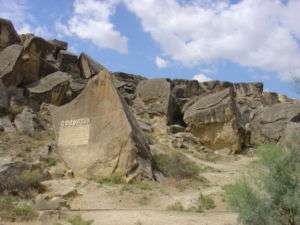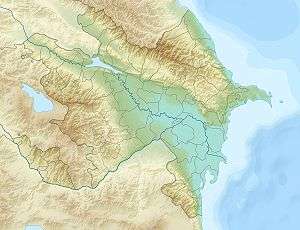Gobustan National Park
| UNESCO World Heritage site | |
|---|---|
 Entrance to the Gobustan Rock Art Cultural Landscape Reserve | |
| Location | Azerbaijan |
| Includes |
|
| Criteria | Cultural: (iii) |
| Reference | 1076rev |
| Inscription | 2007 (31st Session) |
| Area | 537.22 ha (1,327.5 acres) |
| Buffer zone | 3,096.34 ha (7,651.2 acres) |
| Coordinates | 40°7′30″N 49°22′30″E / 40.12500°N 49.37500°ECoordinates: 40°7′30″N 49°22′30″E / 40.12500°N 49.37500°E |
 Location of Gobustan National Park in Azerbaijan | |
Gobustan State Reserve located west of the settlement of Gobustan, about 40 miles southwest of the centre of Baku was established in 1966 when the region was declared as a national historical landmark of Azerbaijan in an attempt to preserve the ancient carvings, mud volcanoes and gas-stones in the region.
Gobustan State Reserve is very rich in archeological monuments, the reserve has more than 6,000 rock carvings, which depict primitive people, animals, battle-pieces, ritual dances, bullfights, boats with armed oarsmen, warriors with lances in their hands, camel caravans, pictures of sun and stars, on the average dating back to 5,000-20,000 years.
Gobustan State Historical and Cultural Reserve acquired national status in 2006. As a part of the 31st Session of the UNESCO World Legacy Committee held in Christchurch, New Zealand on June 23 - July 2, 2007 included within the World Social Legacy List.[1]
Prehistoric carvings
The rock carvings and petroglyphs at the site display mesmerizing images of prehistoric life in the Caucasus. The well-preserved sketches display ancient populations travelling on reed boats; men hunting antelope and wild bulls, and women dancing. [2] The famed Norwegian anthropologist Thor Heyerdahl returned many times to Azerbaijan between 1961 and his death in 2002 to study the site in his "Search for Odin".
The language of the antiquated population of Gobustan, or talking in common, is one of the disputable issues. But they still give information about themselves, about their lives through the drawings they have acquired from them. More than 4-5,000 animal, human pictures, natural life experiences, chasing and dance scenes from the eras coming from each other for thousands of years have been more than once outlined by antiquated painting school. Most of the drawings were drawn on large cliffs, which are the dividers of the residences and in some cases over the ancient ones. The drawings on the rocks initially begun with natural animal figures and human drawings, and at that point, irregularly, as well as schematically, reduced, and even closer to the measurements of the animals and people. One of the unmistakable highlights of Gobustan drawing is that foot muscles of chasing individuals have clearly portrayed, their heads are smaller and their features are nose, mouth, eyes, ears, and so on. have been not given. Specialists note that it is not conceivable to clarify that those who draw it are not able to draw that part properly. Since within the field of painting they were able to manage with more troublesome and complicated tasks. Within the rock drawings, nearly all the basic highlights of tribal life have been reflected in their substances. Pictures from the Seven Beauties cave appears that in chasing women also attended. [3][4][5]
Mud volcanoes
It's estimated that 300 of the planet's estimated 700 mud volcanoes sit in Gobustan, Azerbaijan and the Caspian Sea. [6] Many geologists as well as locals and international mud tourists trek to such places as the Firuz Crater, Gobustan, Salyan and end up happily covered in mud which is thought to have medicinal qualities. In 2001 one mud volcano 15 kilometers from Baku made world headlines when it suddenly started spewing flames 15 meters high. [7]
Flora and fauna
The nature of Gobustan is much more suitable than other regions of Azerbaijan. However, the natural conditions of these places were completely different in 20-25 thousand years ago. From the drawings of animals and human figures on the Gobustan, rocks seem to have been under warm climate from 10 to 12 thousand years. People were wearing gentle clothes, men tightened their paws, and women were wearing short leather dresses. Because of the permanent hot weather, greenery and abundant water, these places were the habitats of wild animals: bulls, horses, deer, goats, and other animals lived in Gobustan. From the rock drawings and the archeological findings, wolves, tigers, foxes, jackals and other wild animals have been found in this place in ancient times. In 1968 while cutting off 3m depth stone layer near Atbulakh, accidentally the large bones of an unknown animal were cut off. The workers informed the Ministry of Culture of the Azerbaijan SSR, not knowing what those bones were. After the investigation of the discovered bones, it was determined that these bones were the VI bone of the neck of the southern elephant, which lived in Gobustan. [5][8]
Gaval Dash
The Gaval Dash is a natural musical stone which can only be found in Gobustan, Azerbaijan. Among the stone books there are a big flat stone formed out of 3 supports. Suffice it to touch the object with a small stone, musical sounds come from it. The stone is called Gaval Dash, the sound can be compared with a tambourine. The Gaval Dash have been formed due the combination of unqiue climate, oil and gas which can be found in the region of Azerbaijan. [4]
External links
- Gobustan from "Window to Baku"
- The Rock Engravings of Gobustan from a site devoted to Jean Auel's books.
- Archaeoastronomy relating the petroglyphs to other ancient carvings and the theories of Thor Heyerdahl
See also
References
- ↑ "Gobustan State Historical-Artistic Reserve".
- ↑ "Early Man in Azerbaijan When Ancient Stones Speak by Ronnie Gallagher and Abbas Islamov". www.azer.com. Retrieved 2018-09-26.
- ↑ "Qobustan". unesco.mfa.gov.az. Retrieved 2018-09-26.
- 1 2 "ГАВАЛДАШ" (PDF).
- 1 2 "Духовный Мир Конных И Лодочных Охотников Эпохи Бронзы Азербайджана" (PDF).
- ↑ "Mud Volcanoes - Mysterious Phenomena Fascinate Scientists and Tourists by Ronnie Gallagher". www.azer.com. Retrieved 2018-09-26.
- ↑ "Azeri mud volcano flares". 2001-10-29. Retrieved 2018-09-26.
- ↑ "Петроглифы Гобустана".